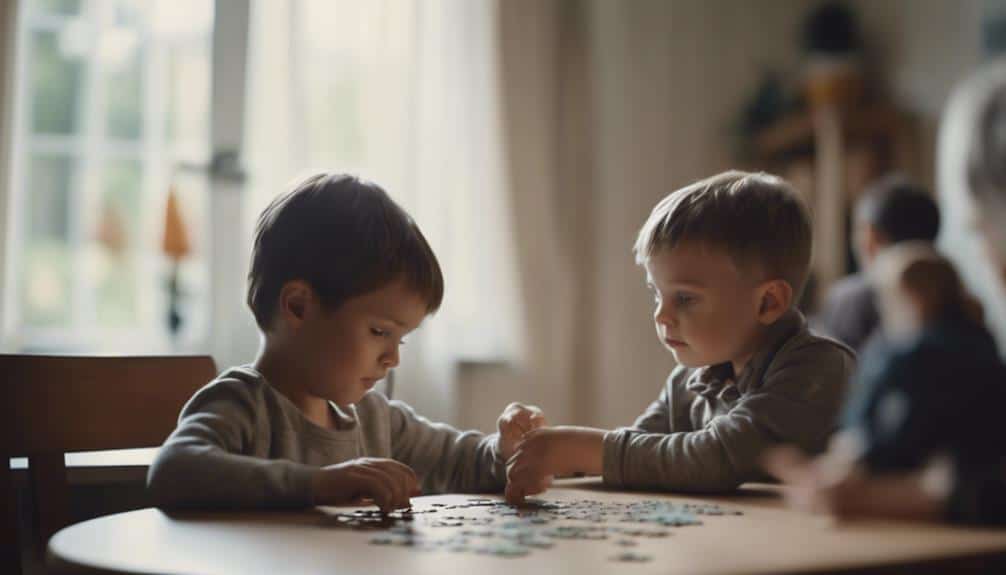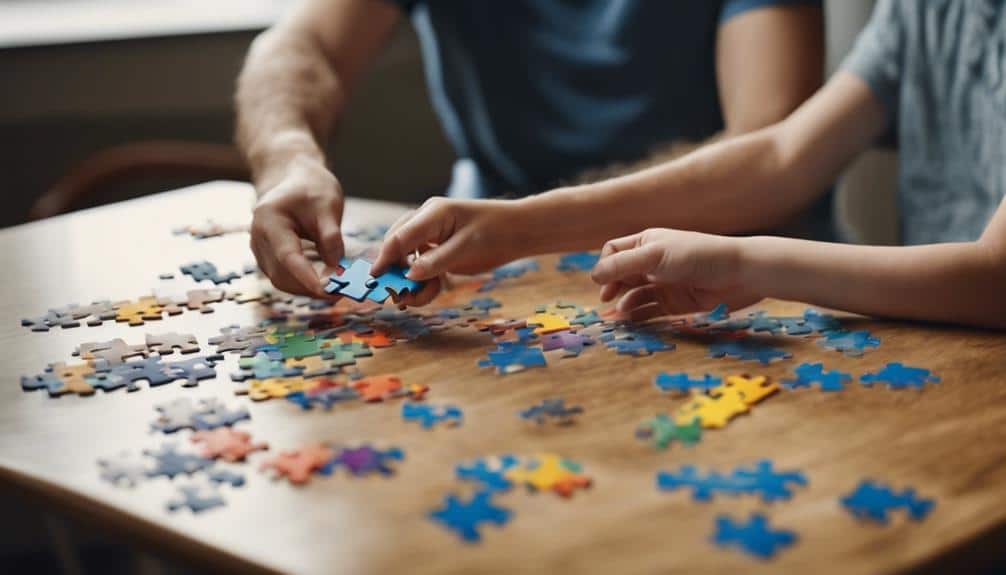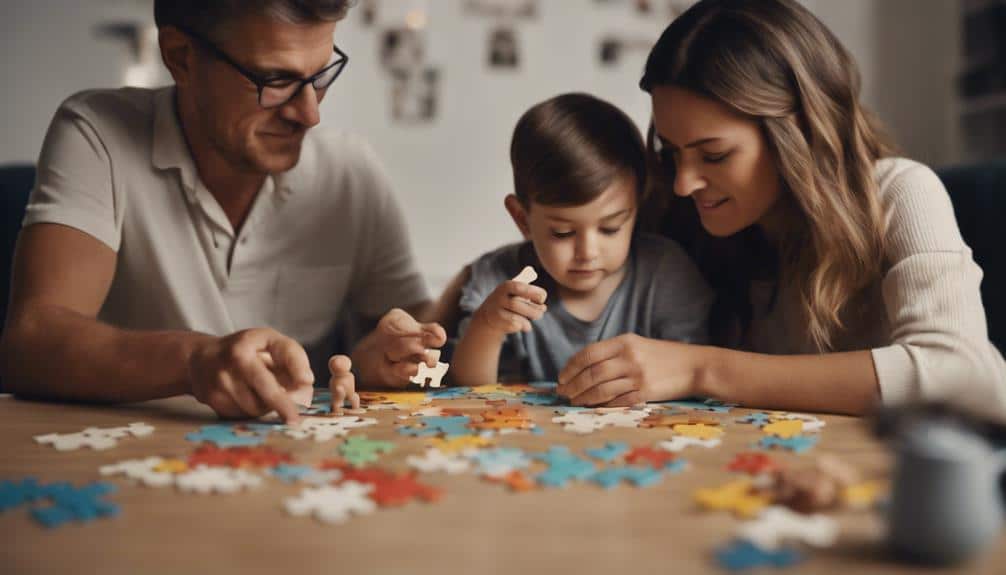Collaboration between parents and therapists is super essential for kids with autism. We have a guide called ‘7 Top Techniques for Parent-Therapist Autism Collaboration’ that shows critical strategies. It helps with talking better, keeping routines, and working towards common goals, making a big difference for the child.
But there’s more to explore to make these strategies work even better. It’s like uncovering secrets to help the child even more. This guide, known as ‘The Art of Autism,’ can guide parents and therapists on this journey, showing them how to implement these helpful practices for the child’s benefit.
So, let’s dive into ‘The Art of Autism’ and discover how we can improve things together!
Key Takeaways
- Establish regular meetings to foster open communication and collaborative strategy development.
- Create consistent routines and celebrate progress to maintain motivation.
- Adapt strategies based on developmental shifts and individual needs for personalized support.
- Implement tailored behavioral interventions to enhance engagement and motivation.
Establishing Communication Goals
To enhance the therapeutic outcomes for children with autism spectrum disorders (ASD), establishing well-defined communication goals is a critical first step in facilitating effective collaboration between parents and therapists. This foundational aspect of the parent-therapist partnership focuses on creating a strategic pathway to improve interactions and understanding between families and children with ASD. By setting clear communication objectives, both parties can align on intervention strategies seamlessly integrated into the child’s daily routines and interactions, fostering a consistent and supportive environment.
Effective strategies tailored around these goals encompass promoting verbal and nonverbal communication, enhancing social skills, and nurturing emotional expression. This holistic approach aims to improve the child’s ability to communicate and reduce behavioral challenges through better emotional regulation and understanding. Consequently, these efforts lead to improved relationships within the family and a more harmonious home environment.
Establishing communication goals is evidence-based and structured, requiring ongoing analysis and adjustments to align with the child’s evolving needs. Through this meticulous and collaborative effort, parents and therapists can achieve significant progress in addressing the multifaceted challenges faced by children with ASD, ultimately leading to better overall outcomes.
Scheduling Regular Meetings
Scheduling regular meetings between parents and therapists plays a pivotal role in reinforcing the collaborative effort required to optimize therapeutic interventions for children with autism. These structured interactions are vital for enhancing communication, which is foundational in tailoring intervention strategies that cater to the unique needs of each child. These meetings ensure that therapy remains dynamic and responsive by dedicating time to discuss progress, challenges, and adjustments.
| Key Aspect | Benefit |
|---|---|
| Progress Updates | Allows for real-time adjustments to therapy plans. |
| Strategy Adjustments | Ensures interventions are aligned with the child’s evolving needs. |
| Goal Setting | Facilitates a focused approach toward achieving specific outcomes. |
| Holistic Understanding | Promotes a comprehensive view of the child’s well-being and progress. |
Regular scheduling of meetings fosters a structured approach to treatment, promoting accountability and consistency among all stakeholders. It also encourages teamwork, as parents and therapists align their efforts toward supporting the child. This practice aligns strategies and interventions and bolsters the mutual understanding and trust necessary for a successful partnership in navigating the complexities of autism therapy.
Sharing Observations

Building on the foundation of regular meetings, sharing observations between parents and therapists emerges as a critical step in enhancing the understanding of a child’s unique behaviors and needs within the autism spectrum. This collaborative effort is instrumental in developing a comprehensive view that integrates the child’s experiences across different settings, from home to therapy sessions.
For children with ASD, the synergy between familial insights and professional expertise cannot be overstated. By constantly interacting with their child, parents can offer nuanced observations of behaviors, responses, and potential triggers that may not be as evident in a clinical setting. When shared, these insights provide therapists with a more decadent, contextual backdrop against which to tailor intervention strategies.
Conversely, therapists contribute a structured analytical lens to interpret these observations, identifying patterns and making connections that might not be immediately obvious. This exchange aligns perspectives on the child’s progress and challenges and fosters a holistic approach to intervention. Such a collaborative framework ensures that strategies are not just theoretically sound but are grounded in the lived realities of the children they aim to help, paving the way for more effective and personalized support.
Creating Consistent Routines
Establishing consistent routines is paramount for children with autism, as it creates a structured environment that significantly reduces anxiety and enhances overall behavior. This structured approach is not just beneficial; it’s essential for fostering a sense of security and predictability, which, in turn, aids in developing social and communication skills. By strategically implementing consistent routines, children are better equipped to manage transitions and engage more effectively in learning and social interactions.
Critical elements of creating compelling, consistent routines include:
- Utilization of Visual Schedules: Visual schedules are a powerful tool in reinforcing daily routines, making abstract concepts of time and sequence more concrete and understandable for children with autism. This visual aid supports independence development and improves time management skills.
- Repetition and Predictability: Regularly repeating the same routines provides a framework of predictability, which is essential for anxiety reduction. This consistency helps children understand expectations and adapt to transitions more smoothly, leading to behavior improvement.
- Parent-Therapist Collaboration: A collaborative approach ensures that routines are consistently applied across different environments, such as home and school. This unified strategy enhances the child’s generalization skills, promoting stability and comfort across various settings.
Implementing Joint Strategies

Implementing joint strategies requires a collaborative effort between parents and therapists to design and enforce consistent interventions that enhance the developmental progress of children with autism. This collaborative approach ensures alignment in methods and goals, which is critical for addressing autism spectrum disorders effectively. A powerful synergy is created by combining the expertise of professionals, such as Speech Therapists and Applied Behavior analysts, with the intimate knowledge parents hold of their child’s unique needs and behaviors. This partnership fosters a conducive environment for improving communication, social skills, and other areas critical to the child’s development.
Joint strategies particularly excel in integrating therapeutic techniques into the child’s daily routines, ensuring that social communication and interaction improvements are not confined to therapy sessions but are practiced and reinforced in the home environment. Family therapy for autism plays a pivotal role in this context, offering structured opportunities for parents to learn and apply therapeutic strategies under professional guidance. This consistent implementation across settings is vital for children with autism spectrum, as it helps bridge the gap between learned behaviors in therapy and their application in real-world scenarios, leading to more robust and lasting developmental gains.
Celebrating Progress Together
Recognizing and celebrating progress together acts as a pivotal mechanism for fostering a positive and motivating environment conducive to the therapeutic journey of children with autism. This process acknowledges all parties’ hard work and dedication and is a cornerstone for building a resilient and supportive framework. The act of celebrating progress together can be structured through several evidence-based strategies:
- Highlighting Small Achievements: Acknowledging even the most minor steps forward can significantly boost morale and encourage continued effort from the child, reinforcing the value of perseverance and patience in the therapeutic process.
- Jointly Recognizing Milestones: When parents and therapists celebrate milestones, it strengthens their bond, fostering a united front crucial for the child’s sense of security and belonging.
- Sharing Success Stories: Reflecting on and sharing success stories inspires hope and bolsters confidence in the efficacy of the therapeutic interventions, reinforcing the collaborative partnership’s commitment to supporting the child’s development.
Through these approaches, celebrating progress together cultivates a positive environment that enhances motivation, encourages effort, and solidifies the collaborative partnership essential for navigating the complexities of autism therapy.
Adjusting Approaches as Needed

Effective parent-therapist collaboration in autism care necessitates continuously adapting intervention strategies to meet the child’s evolving needs. This process includes the implementation of flexible strategy modifications, the recognition of developmental shifts, and the utilization of tailored communication techniques. Such adjustments are grounded in regular assessments and open communication, ensuring therapeutic approaches remain personalized and responsive to the child’s progress.
Flexible Strategy Modifications
Adapting therapy strategies to align with the evolving needs and responses of children with autism is pivotal for optimizing their progress and engagement in treatment sessions. Utilizing flexible strategies, therapists can effectively adjust therapy approaches to cater to individual needs, ensuring each child receives the most beneficial intervention. This adaptability is crucial for:
- We are enhancing optimal engagement and motivation during therapy.
- We promote consistent skill development tailored to the child’s unique learning style.
- It is developing personalized treatment plans that facilitate successful outcomes.
Recognize Developmental Shifts
As children with autism navigate through various developmental stages, therapists must identify and respond to these shifts by adjusting their intervention strategies to maintain therapeutic momentum and efficacy. Recognizing developmental shifts allows therapists to tailor therapy techniques effectively, ensuring continuous progress in therapy. This adaptability is crucial for addressing emerging challenges and goals that accompany each stage of development. Flexibility in therapy approaches is essential to meet the evolving needs of autistic children, particularly as they face new communication difficulties. By adjusting intervention approaches in response to observed developmental shifts, therapists can provide a more responsive and effective therapeutic environment, fostering an atmosphere of growth and learning that aligns with the changing needs of autistic children.
Tailored Communication Techniques
Tailored communication techniques are essential for personalizing therapy to meet the unique needs and preferences of children with autism, involving adjustments in approaches such as visual supports, language modification, and the integration of special interests.
- Visual Supports: Visual aids can significantly enhance understanding and engagement for children with varying communication styles and sensory sensitivities.
- Modifying Language: Adjusting the complexity and form of language according to the child’s comprehension level fosters better rapport and facilitates more transparent communication.
- Special Interests: Integrating individual interests into therapy sessions can increase motivation and participation, making therapeutic goals more attainable.
Frequently Asked Questions
When we think of the art of autism, what are we considering the “art”?
The Art of Autism’ involves a dynamic collaboration between parents, therapists, and teachers. It emphasizes open communication, consistent routines, and shared goals, fostering a supportive environment for the child’s progress. Through this collaborative approach, parents, therapists, and teachers work together to tailor interventions, address challenges, and celebrate the child’s achievements, ensuring a holistic and effective strategy for the child’s success.
What Therapy Approach Is Best for Autism?
Determining the optimal therapy approach for autism necessitates a tailored, multidisciplinary strategy incorporating DIRFloortime, ABA, speech, occupational, and cognitive behavioral therapies, alongside social skills training, to address the individual’s unique needs effectively.
What Is the Autistic Burnout Cycle?
The autistic burnout cycle, experienced by many on the spectrum, involves profound mental and physical exhaustion from constant neurotypical adaptation. Addressing this through sensory regulation and professional support is essential for mitigating its detrimental impacts.
What Are at Least Three Strategies That Could Be Used to Support Communication and Social Interaction With Autism?
Three effective strategies for supporting communication and social interaction in autism include structured play activities, using visual supports such as picture schedules, and implementing social skills training programs focusing on foundational social behaviors.
What Are Some Coping Strategies for Autism?
Effective coping strategies for autism include utilizing visual schedules for structure, creating sensory-friendly environments to reduce overload, teaching relaxation techniques like deep breathing for stress management, and employing social stories to enhance social skills.
Conclusion
Autism Spectrum Disorders (ASD) can affect the way a person perceives the world and interacts with others. Children with ASD may have difficulty with social skills, communication, and behavior. The characteristics of autism can make educational experiences challenging for both the student with autism and their classroom teachers. To ensure positive outcomes for the autistic person, a collaborative team of teachers, occupational therapists, physical therapists, speech-language pathologists, and Art Therapists can create a personalized educational experience.
The interdisciplinary team can use DIRFloortime to teach autistic children new skills while reducing disruptive behavior. Students with autism will benefit from visual schedules and loud noise reduction to help them focus on their studies. Art Therapy classes can also provide a safe space for autistic children to express themselves creatively. Teachers and art teachers can work together to design class schedules and academic offerings that cater to the needs of students with autism.
Effective collaboration requires communication skills and a transdisciplinary approach. The team must be aware of alternative therapies, scientific evidence, and the latest research in autism diagnosis and treatment. The Journal of Autism and Developmental Disorders is an excellent resource for the latest information. Facial expressions and body language can be complex for autistic people to interpret, so the team must develop a comprehensive approach considering the client’s motor skills and sensory experiences.
In conclusion, collaborative and interdependent practices are essential to effective client care for individuals with autism spectrum disorders. Classroom aides can also support autistic students’ interactions with peers and teachers. With the help of interdisciplinary collaboration, students with autism can have a positive learning experience and develop the social, emotional, and motor skills necessary to thrive in school and beyond.


Recent Comments